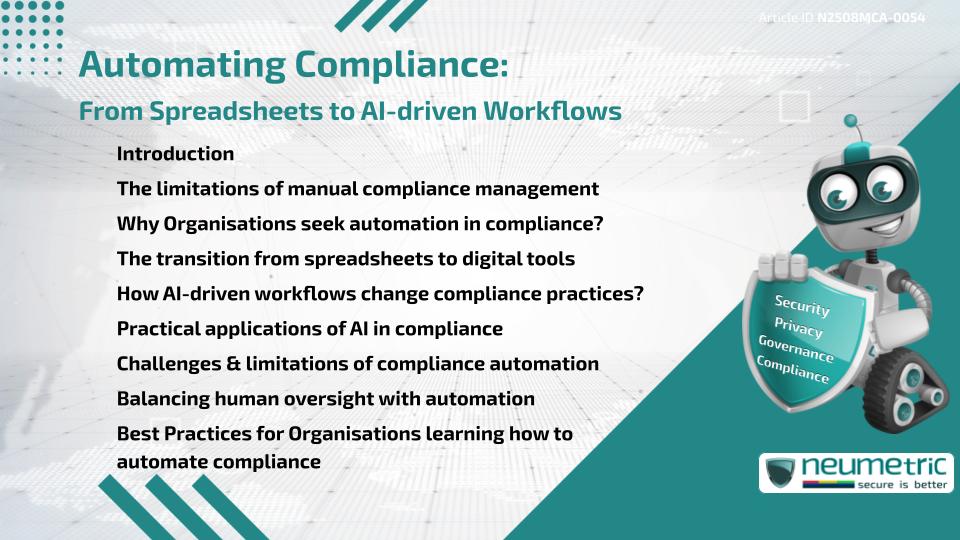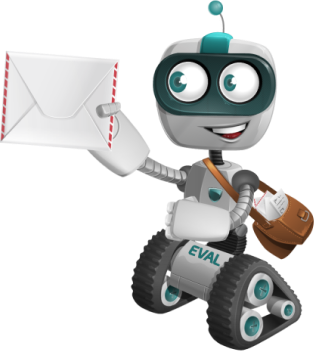Table of Contents
ToggleIntroduction
In today’s regulatory landscape, Organisations face rising pressure to maintain accuracy, transparency & timeliness in compliance reporting. Many still rely on spreadsheets, which are prone to errors & inefficiencies. This article explores how to automate compliance effectively by transitioning from manual processes to AI-driven workflows. It examines the limitations of spreadsheets, the benefits of automation, practical applications of Artificial Intelligence & the balance between technology & human oversight. By the end, readers will understand why the shift from spreadsheets to AI workflows is essential for reducing Risks, saving costs & improving Governance.
The limitations of manual compliance management
For years, spreadsheets have been the backbone of compliance tracking. While familiar & accessible, they present major drawbacks. Human errors in data entry, version control issues & difficulty managing large datasets increase the Risk of non-compliance. Manual reporting also slows down audits & reduces real-time visibility. These weaknesses highlight why Organisations are actively exploring how to automate compliance.
Why Organisations seek automation in compliance?
The demand for automation stems from the need for efficiency, accuracy & scalability. Automated tools reduce repetitive tasks, provide real-time monitoring & standardize processes. Unlike spreadsheets, automation ensures traceability & minimizes the Risks of data loss. For businesses operating in highly regulated industries such as Finance or Healthcare, automation directly supports better Governance & Risk Management.
The transition from spreadsheets to digital tools
The first step in automation often involves moving from spreadsheets to specialized compliance management software. These tools centralize documentation, create Audit-ready records & generate alerts for regulatory updates. This digital foundation makes it easier for Organisations to progress toward advanced AI-driven workflows. The transition is not only about efficiency but also about ensuring compliance systems can scale with growing organizational needs.
How AI-driven workflows change compliance practices?
AI-driven workflows go beyond digitization. They leverage machine learning algorithms to detect anomalies, assess Risks & automate decisions. For example, AI can cross-check thousands of compliance entries in seconds, flagging suspicious activity or missing documentation. These workflows provide predictive insights, allowing Organisations to identify potential Risks before they escalate. In practical terms, this transformation answers the pressing question of how to automate compliance at scale.
Practical applications of AI in compliance
AI plays an increasingly vital role in several areas of compliance:
- Continuous Monitoring: AI tools track regulatory changes & update requirements automatically.
- Risk scoring: Algorithms assign Risk levels to transactions or entities for faster analysis.
- Pattern detection: Machine learning models uncover trends that might indicate fraud or breaches.
- Audit readiness: Automated systems prepare comprehensive reports, reducing Audit preparation times.
These applications demonstrate how to automate compliance in ways that not only cut costs but also improve Governance Standards.
Challenges & limitations of compliance automation
Despite its advantages, compliance automation is not without challenges. Implementing AI-driven workflows requires significant investment in technology & training. Smaller Organisations may find the costs prohibitive. Moreover, AI Systems depend on the quality of data they are fed; poor data leads to inaccurate results. Over-reliance on automation can also create blind spots if human oversight is neglected.
Balancing human oversight with automation
Automation should not replace human judgment but complement it. Compliance officers provide context, ethical reasoning & decision-making that AI cannot replicate. Successful Organisations combine automated workflows with expert oversight, ensuring accuracy while maintaining accountability. This balance is vital in understanding how to automate compliance without compromising ethical or regulatory responsibilities.
Best Practices for Organisations learning how to automate compliance
For Organisations beginning their automation journey, several Best Practices stand out:
- Start small: Begin with a single compliance area, such as reporting or monitoring.
- Ensure data integrity: Validate data before feeding it into AI Systems.
- Train staff: Educate teams on both the use of tools & the importance of oversight.
- Measure performance: Track efficiency, error reduction & compliance outcomes regularly.
- Review regulations: Keep systems updated with evolving legal requirements.
Following these steps ensures that the transition from spreadsheets to AI-driven workflows is smooth & effective.
Takeaways
- Spreadsheets are no longer sufficient for modern compliance demands.
- Automation provides efficiency, accuracy & real-time oversight.
- AI-driven workflows enhance predictive analysis & Risk detection.
- Human oversight remains critical for ethical & contextual decision-making.
- Best Practices include starting small, ensuring data quality & Continuous Monitoring.
FAQ
What does it mean to automate compliance?
Automating compliance means using digital tools & AI workflows to manage regulatory requirements, reduce manual tasks & improve accuracy.
Why are spreadsheets risky for compliance management?
Spreadsheets are prone to errors, version control issues & inefficiencies that can result in non-compliance or Financial penalties.
How do AI-driven workflows improve compliance?
AI-driven workflows detect anomalies, automate reporting & provide predictive insights, making compliance faster & more reliable.
Can Small Businesses automate compliance?
Yes, smaller Organisations can start with affordable compliance software, gradually adopting AI features as their needs grow.
Does automation remove the need for compliance officers?
No, compliance officers remain essential. Automation reduces repetitive tasks, but human oversight ensures accuracy & ethical judgment.
What industries benefit most from compliance automation?
Industries such as Finance, Healthcare & Manufacturing benefit significantly due to strict regulatory requirements.
What are the challenges of automating compliance?
Challenges include high initial costs, data quality issues & the Risk of over-reliance on automation without human oversight.
Need help for Security, Privacy, Governance & VAPT?
Neumetric provides organisations the necessary help to achieve their Cybersecurity, Compliance, Governance, Privacy, Certifications & Pentesting needs.
Organisations & Businesses, specifically those which provide SaaS & AI Solutions in the Fintech, BFSI & other regulated sectors, usually need a Cybersecurity Partner for meeting & maintaining the ongoing Security & Privacy needs & requirements of their Enterprise Clients & Privacy conscious Customers.
SOC 2, ISO 27001, ISO 42001, NIST, HIPAA, HECVAT, EU GDPR are some of the Frameworks that are served by Fusion – a SaaS, multimodular, multitenant, centralised, automated, Cybersecurity & Compliance Management system.
Neumetric also provides Expert Services for technical security which covers VAPT for Web Applications, APIs, iOS & Android Mobile Apps, Security Testing for AWS & other Cloud Environments & Cloud Infrastructure & other similar scopes. Reach out to us by Email or filling out the Contact Form…


